UPDATED TUES. - APRIL 1, 2008
************************************
Signs of Satan!
 | Well known people showing off the hand signal which represents Satan. |
The following is an excerpt above from the "Satanic Bible"...
Horned Hand or The Mano Cornuto:
This gesture is the Satanic salute, a sign of recognition between and allegiance of members of Satanism or other unholy groups.
I Love You, Devil?

 The "El Diablo" hand sign often is con-fused with the deaf hand signal of the phrase, "I love you." While at first this appears an odd resemblance, we register an "ahh, I get it!" emotion when we discover that the person who invented, or created, the hand sign system for the deaf, Helen Keller, was herself an occultist and Theosophist. Did Keller purposely design the deaf's "I love you" sign to be such a remarkable imitation of the classic sign of Satan? Was Keller saying, basically, "I love you, Devil?" -Texe Marrs (See CODEX MAGICA).
The "El Diablo" hand sign often is con-fused with the deaf hand signal of the phrase, "I love you." While at first this appears an odd resemblance, we register an "ahh, I get it!" emotion when we discover that the person who invented, or created, the hand sign system for the deaf, Helen Keller, was herself an occultist and Theosophist. Did Keller purposely design the deaf's "I love you" sign to be such a remarkable imitation of the classic sign of Satan? Was Keller saying, basically, "I love you, Devil?" -Texe Marrs (See CODEX MAGICA).
"She invented over 60 different signs by which she could talk to her family before the age of seven. For example, if she wanted ice cream she would wrap her arms around herself and pretend to shiver." -SOURCE
Satanists or just a mere coincidence?



Prince William

Maria (Kennedy) Shriver at her marriage to Arnold Schwarzenegger

George W Bush
(Member of Skull and Bones, and Bohemian Grove)

Tom Ridge, former Homeland Security Director
Above: Outgoing Homeland Security Director Tom Ridge (formerly Governor of Pennsylvania). Surely he's not a Longhorns Fan?

Senator John Edwards
Above: Former North Carolina Senator John Edwards (also the Democratic Vice Presidential candidate in 2004). Is he a Texas Longhorns fan too?

Yasser Arafat


Italian Prime minister Berlusconi
................................................................................................
USA 2008: The Great Depression
Food stamps are the symbol of poverty in the US. In the era of the credit crunch, a record 28 million Americans are now relying on them to survive – a sure sign the world's richest country faces economic crisis
Tuesday, 1 April 2008
We knew things were bad on Wall Street, but on Main Street it may be worse. Startling official statistics show that as a new economic recession stalks the United States, a record number of Americans will shortly be depending on food stamps just to feed themselves and their families.
Dismal projections by the Congressional Budget Office in Washington suggest that in the fiscal year starting in October, 28 million people in the US will be using government food stamps to buy essential groceries, the highest level since the food assistance programme was introduced in the 1960s.
The increase – from 26.5 million in 2007 – is due partly to recent efforts to increase public awareness of the programme and also a switch from paper coupons to electronic debit cards. But above all it is the pressures being exerted on ordinary Americans by an economy that is suddenly beset by troubles. Housing foreclosures, accelerating jobs losses and fast-rising prices all add to the squeeze.
Emblematic of the downturn until now has been the parades of houses seized in foreclosure all across the country, and myriad families separated from their homes. But now the crisis is starting to hit the country in its gut. Getting food on the table is a challenge many Americans are finding harder to meet. As a barometer of the country's economic health, food stamp usage may not be perfect, but can certainly tell a story.
Michigan has been in its own mini-recession for years as its collapsing industrial base, particularly in the car industry, has cast more and more out of work. Now, one in eight residents of the state is on food stamps, double the level in 2000. "We have seen a dramatic increase in recent years, but we have also seen it climbing more in recent months," Maureen Sorbet, a spokeswoman for Michigan's programme, said. "It's been increasing steadily. Without the programme, some families and kids would be going without."
But the trend is not restricted to the rust-belt regions. Forty states are reporting increases in applications for the stamps, actually electronic cards that are filled automatically once a month by the government and are swiped by shoppers at the till, in the 12 months from December 2006. At least six states, including Florida, Arizona and Maryland, have had a 10 per cent increase in the past year.
In Rhode Island, the segment of the population on food stamps has risen by 18 per cent in two years. The food programme started 40 years ago when hunger was still a daily fact of life for many Americans. The recent switch from paper coupons to the plastic card system has helped remove some of the stigma associated with the food stamp programme. The card can be swiped as easily as a bank debit card. To qualify for the cards, Americans do not have to be exactly on the breadline. The programme is available to people whose earnings are just above the official poverty line. For Hubert Liepnieks, the card is a lifeline he could never afford to lose. Just out of prison, he sleeps in overnight shelters in Manhattan and uses the card at a Morgan Williams supermarket on East 23rd Street. Yesterday, he and his fiancée, Christine Schultz, who is in a wheelchair, shared one banana and a cup of coffee bought with the 82 cents left on it.
"They should be refilling it in the next three or four days," Liepnieks says. At times, he admits, he and friends bargain with owners of the smaller grocery shops to trade the value of their cards for cash, although it is illegal. "It can be done. I get $7 back on $10."
Richard Enright, the manager at this Morgan Williams, says the numbers of customers on food stamps has been steady but he expects that to rise soon. "In this location, it's still mostly old people and people who have retired from city jobs on stamps," he says. Food stamp money was designed to supplement what people could buy rather than covering all the costs of a family's groceries. But the problem now, Mr Enright says, is that soaring prices are squeezing the value of the benefits.
"Last St Patrick's Day, we were selling Irish soda bread for $1.99. This year it was $2.99. Prices are just spiralling up, because of the cost of gas trucking the food into the city and because of commodity prices. People complain, but I tell them it's not my fault everything is more expensive."
The US Department of Agriculture says the cost of feeding a low-income family of four has risen 6 per cent in 12 months. "The amount of food stamps per household hasn't gone up with the food costs," says Dayna Ballantyne, who runs a food bank in Des Moines, Iowa. "Our clients are finding they aren't able to purchase food like they used to."
And the next monthly job numbers, to be released this Friday, are likely to show 50,000 more jobs were lost nationwide in March, and the unemployment rate is up to perhaps 5 per cent.
..............................................................................................
Corbon .45 Auto Rim 160-gr. DPX
By Stephen Camp
The .45 Auto Rim has never been what anyone would call a big seller. For years it was available from Remington in a 230-gr. LRN @ approximately 800 ft/sec. Ammunition was expensive and lackluster in performance, but very nice things could be done if a handloader.
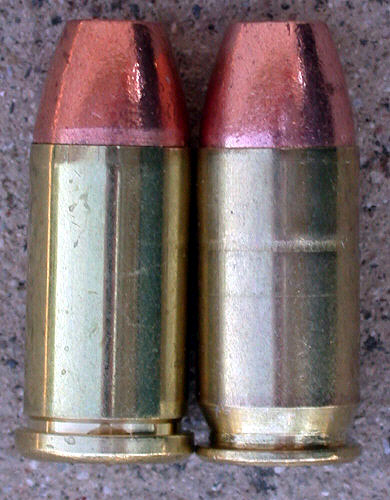
On the left is Corbon's 160-gr. DPX auto rim round and on the right, their .45 ACP "Compact Gun Load," the same bullet at the same nominal velocity, but in the familiar ACP case. Note the very great difference in the auto rim's rim. This is because no clip is used. These work in .45 ACP revolvers the same way other rimmed revolver cartridges do. They will not work in the automatic pistols. Corbon's 45 Auto Rim DPX load is a new addition to several popular calibers in this line of ammo.
Were it not for revolvers being made for use with .45 ACP via moon clips, I think the auto rim would be a dead cartridge. For years the only manufacturer of either loaded ammunition or cases was Remington. Starline Brass now makes new cases in this caliber.
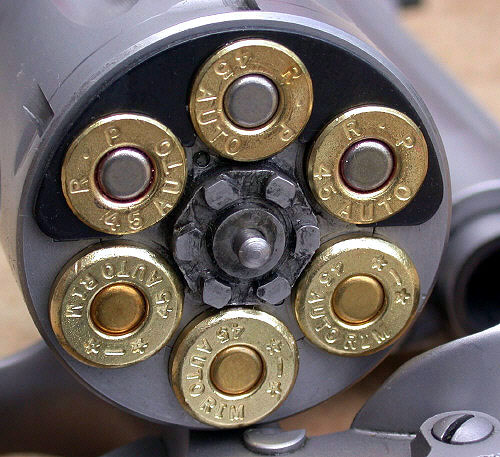
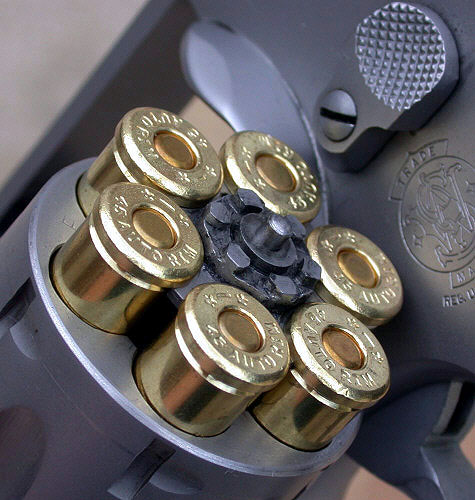
On the left we see a half-moon clip holding 3 rounds of Corbon 160-gr. DPX 45 ACP ammunition. The three rounds at the bottom of the cylinder are the auto rim load as are the six shown in the picture on the right. The auto rim is a revolver cartridge and handles the same as the .38 Special or .357 Magnum.
I believe the auto rim may be saved from extinction for a number of reasons. First, many states have passed concealed carry laws so that more folks are interested in a compact carry gun and more than a few prefer revolvers. Of those, there are people who simply do not trust the "small bores" and believe that a defensive cartridge's caliber designation should start with a "4". Thus, there are some .44 Special, .45 Colt, and .45 ACP revolvers. Other than some convertible .45 ACP/45 Colt single-action revolvers most are traditional double/single action and have swing-out cylinders. In order to hold the cartridge for positive firing and consistent positioning as well as ejection, moon clips are required. These are available in two forms: full moon, which holds a full six in the case of .45 ACP and half moon, which holds three.
The use of moon clips is almost universally acknowledged as a pain in the rear end. They can be difficult to load and are always a little slice of hell to unload. Tools to make removal of empty hulls do exist in various forms and I use a rather inexpensive one myself.
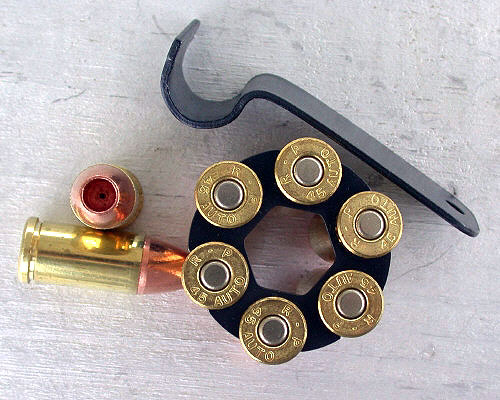
On the left we see two Corbon 160-gr. DPX cartridges in .45 Auto Rim. Next to them are a full moon clip of .45 ACP and a tool for removing fired cases from the clip. This hassle might be a contributing factor in making the auto rim more popular with non-reloaders. HKS makes a speed loader for 45 auto rim. It is their Model 25M and can be found here: http://www.pistoleer.com/hks/revolver.shtml
Corbon is a name long associated with throttle-to-the-firewall +P loads that almost always led the pack with regard to velocity, but they also make heavy bullet hunting loads as well and offer more than one approach to enhanced performance defense ammo. Their latest is the DPX line of anti-personnel cartridges.
DPX stands for Deep Penetrating X-bullet. The X-bullet from Barnes is made completely of a copper alloy and contains no lead. There is no jacket. There is a hollow point to be sure, but the bullet is of the same material through and through. In the manufacturing process, the bullet is designed to expand via six equidistant petals compared to four common to the Barnes line of rifle-caliber X-bullets.
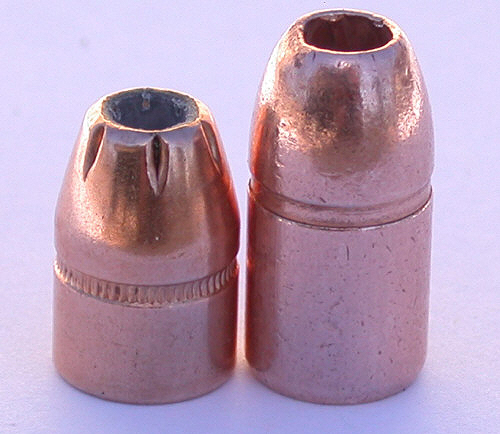
Though in .357 caliber, we can see that the Hornady XTP (conventional jacketed lead) is shorter than the homogeneous X-bullet even though both of these weigh 125-grains. The same is true in 45-caliber. The use of an X-bullet will reduce available powder space more than with a denser lead bullet of the same weight. This is not necessarily a bad thing. The X-bullets used by Corbon in their DPX ammunition is loaded to performance levels rather than the highest possible velocity.
One of Corbon's latest additions to their DPX family of defense ammunition is the .45 auto rim. It is a standard pressure load. The nominal muzzle velocity is listed as 1050 ft/sec, but their website gives no barrel length used for this figure. For all intents and purposes, it is their .45 ACP Compact Gun Load being offered for .45 ACP revolver shooters in a cartridge that negates the need for moon clips.
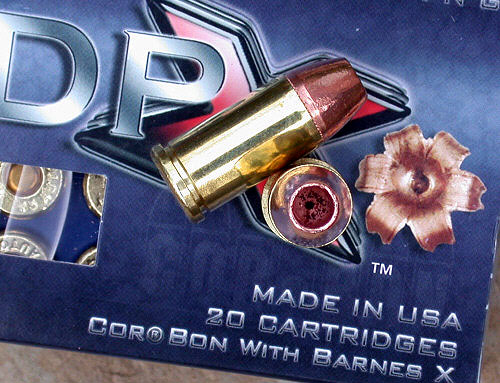
Corbon 45 Auto Rim 160-gr. DPX comes in boxes of twenty. The bullet is the same as is used in their 160-gr. 45 ACP DPX load, but with a cannulure added to insure that the bullet remains secure during recoil from smaller, lighter revolvers.
I recently obtained some of this new ammunition. The only .45 ACP revolver I own is a Smith & Wesson Model 625 with a 5" barrel. This is hardly an ideal concealed carry revolver but it's what I had. I expected velocities to be a bit higher than the published 1050 ft/sec and they were.
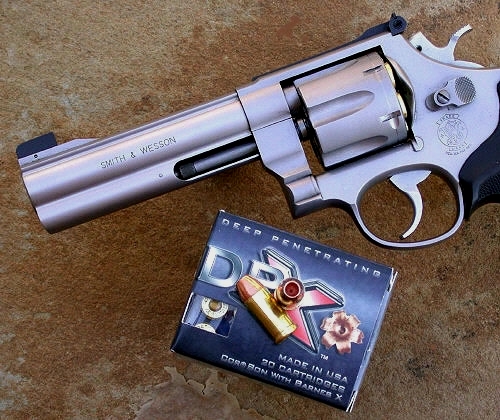
I would have preferred a snub revolver as well in these tests but used the only one I had available. Hopefully this information will still be useful to those with the shorter barrel six-guns.
Using this one revolver, I checked the ammunition for a number of things including accuracy, felt-recoil, and consistency over the chronograph. I also performed my own informal expansion testing using both water and super-saturated newsprint I soaked for 24 hours and drained 30 minutes before shooting.
Shooting: All shooting in today's test was done in slow-fire, single-action, and from a seated position with my wrists braced. I wanted to see if the load was accurate. Though such luxuries are not present in the situations for which this defensive ammo is intended, I personally have no use for ammo that cannot group to my satisfaction. For me, inaccurate or inconsistent ammunition is not acceptable. I was not disappointed.
I fired at distances of 15 and 25 yards, both of which are well beyond normal self-defense scenario parameters. My thinking is that if it will group satisfactorily at 25 yards, it certainly will at 10 feet.
It also occurred to me that probably the most popular bullet weight in .45 ACP is still 230 grains. Therefore, I shot a group of 12 shots at 15 yards using Remington UMC 230-gr. FMJ ammunition to compare with the 160-gr. DPX using the same POA.
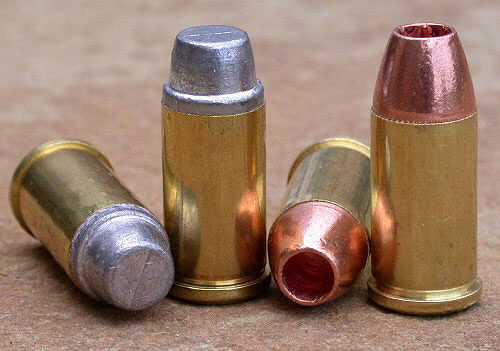
My normal handload for 45 auto rim is a 250-gr. CSWC loaded to 860 ft/sec. This is a very consistent and accurate load. It is shown to the left of the 160-gr. DPX from Corbon. My revolver is sighted in for the handload, but is "close" with the 230-gr. ammunition used by most .45 auto shooters.
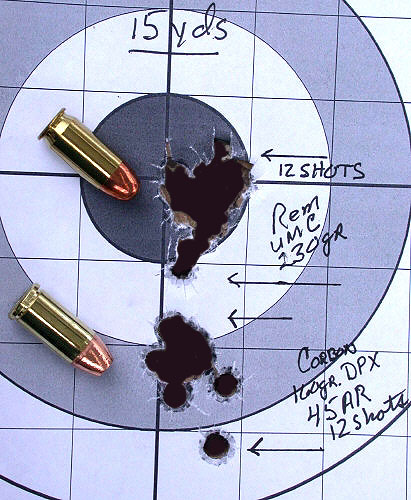
Between each set of arrows (except for one pulled shot) is the group shot at 15 yards with the traditional 230-gr. ammunition and the light-for-caliber DPX. The center of the bullseye was the POA. (When using the 250-gr. CSWC handload, I use a six o'clock hold.) The DPX struck a bit over 2" lower than the FMJ for the same POA at this distance.
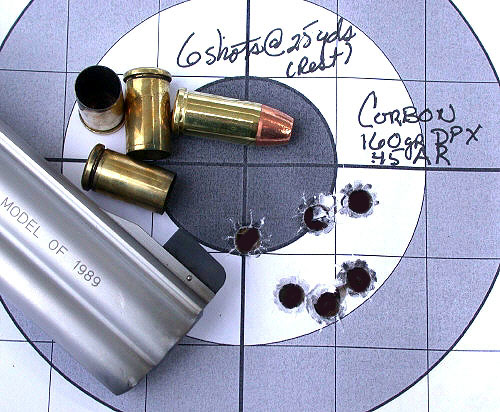
Even though I adjusted the rear sight a bit, I didn't get quite enough vertical adjustment and still hit a bit low at 25 yards when using the center of the bullseye as the POA. This six-shot group is well inside 2".
I did not do any rapid-fire with this load. The reason is that such measures only my ability with this N-frame S&W and may or may not translate meaningfully with either the skill of another shooter using the same or more compact handgun. In other words, I cannot accurately predict how much "combat accuracy" the load has for another. I can say that felt recoil was minimal and felt less than with the Remington ball, which averages 821 ft/sec from this revolver.
Chronograph Results: Ten shots were fired from the revolver to obtain the listed figures below. This was done with the muzzle 10' from the chronograph screens.
From the 5" S&W Model 625, Corbon's 160-gr. 45 AR DPX averaged 1108 ft/sec. The Extreme Spread was 37 with a Standard Deviation of 12. This would have been even closer were it not for the last two shots.
Here are the results for individual shots in feet per second:
Shot #1: 1099
Shot #2: 1100
Shot #3: 1104
Shot #4: 1102
Shot #5: 1098
Shot #6: 1107
Shot #7: 1111
Shot #8: 1105
Shot #9: 1122
Shot #10: 1135
This is very consistent ammunition.
Expansion Testing: As I've mentioned in previous articles, I do not have the money or the controlled environment to use calibrated 10% ballistic gelatin. I generally use two media for testing: water and "wetpack", which is merely super-saturated newsprint I've soaked for 24 hours and then drained 30 minutes prior to shooting.
Fired into water, this standard pressure load expanded every time. Five shots were fired.
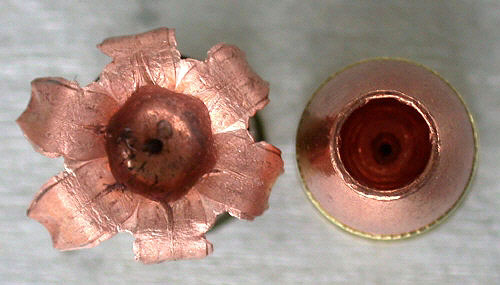
The expanded DPX bullet shown above expanded to 0.782" x 0.605" x 0.63" tall and lost no measurable weight. Average for all five bullets fired into water was 0.784" x 0.631" x 0.461" tall.
Wetpack does not give as accurate estimations of penetration depths as does 10% ballistic gelatin, but Corbon advises that this bullet is designed to penetrated at least the 12" minimum recommended by the FBI. As a "control" I also fired a Winchester 230-gr. Ranger JHP (RA45T) to compare its penetration depth to the 160-gr. DPX. It has an average velocity of 869 ft/sec fired from the 5" S&W.
Ten rounds of 160-gr. DPX were fired into the saturated newsprint and the average penetration depth was 6.25". Ten Winchester Ranger rounds were fired and averaged 6.5" penetration. The Ranger law enforcement ammunition is praised by folks on various sides of the "stopping power" issue as being a consistent expander that can be counted upon to penetrate approximately 14" of 10% ballistic gelatin. Likewise, the Corbon DPX bullet expands consistently after passing through various intermediate barriers such as the dreaded 4-layers-of-denim test. It appears that it will penetrate at least the 12" demanded by most ammo-conscious users these days.
In the wetpack, the average expanded diameter of the Winchester Ranger was 0.75" x 0.73" x 0.462" tall and the bullets neither fragmented nor lost any measurable bullet weight.
Corbon 160-gr. DPX expanded to an average diameter of 0.73" x 0.71" x 0.475" tall.

Shown is a Winchester 230-gr. Ranger JHP flanked by (left) Corbon 160-gr. DPX fired into water and on the right, a DPX fired into wetpack like the Ranger.
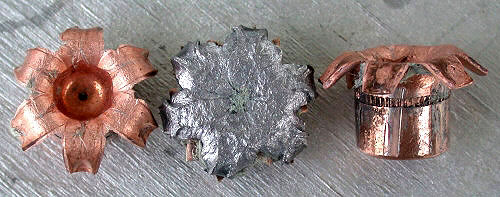
These bullets were all fired into wetpack. Note the cannulure on the DPX for use in the auto rim cartridge. I pulled a couple of bullets with a kinetic bullet puller. Trust me, these will not unseat themselves in recoil.
Conclusion: For folks using the .45 ACP revolver for self-protection against felons, I believe that the Corbon 160-gr. load merits serious consideration. It will probably be used in lighter, more compact revolvers than what I used and with somewhat lower velocities. According to Corbon, this DPX bullet begins to expand at an impact velocity of 800 ft/sec. I can only guess here, but I'll bet that 3" velocities are in line with the 1050 ft/sec listed by the maker. The powder used is flash retardant and is reportedly optimized for use in shorter barrels. I expect velocity lost to be minimal and based on what I saw with the same load in ACP form, estimate it at between 950 and the listed nominal velocity.
(For those interested in the .45 ACP Compact Gun Load in the same bullet weight, follow the link below:
http://www.hipowersandhandguns.com/Corbon%20160%20gr%20DPX.htm)
Earlier I mentioned that felt recoil was less. Putting a calculator to the bullet weights and their measured velocities from my revolver, the Corbon 160-gr. DPX auto rim round generates right at 7% less felt recoil than the Remington UMC 230-gr. FMJ. This should be easily controllable in a compact revolver.
There were no misfires or any problems at all with this ammunition.
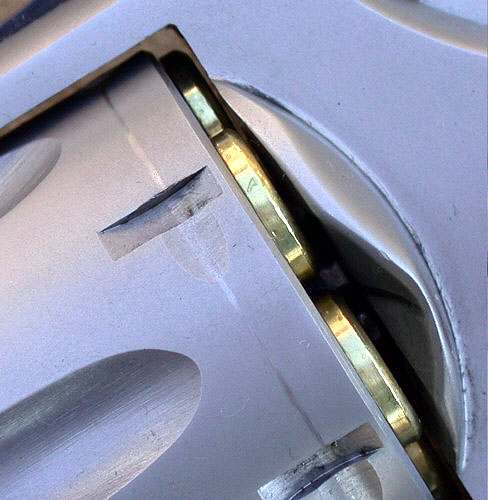
The Starline cases used by Corbon did not bind when used in my S&W revolver and fired cases literally could be shaken out of the cylinder without use of the ejector rod. This load could have been "hotter" but the DPX line is loaded to the levels at which optimum performance occurs. This may not necessarily be at maximum allowable speeds.
Corbon 160-gr. 45 auto rim is intended for distances commensurate with the average deadly force scenario. The bullet is light for caliber and would not be well suited for use at extended distances as might be expected in hunting scenarios. It provides minimal recoil for quick repeat shots and being standard pressure, is easy on the smaller guns it might be used in. Flash retardant powder especially for use in short barrels gives the user all the advantages Corbon can. The ammunition is a consistent expander from what I've seen and capable of very fine accuracy.
Were I toting a small .45 ACP revolver, it would be loaded with this ammunition.
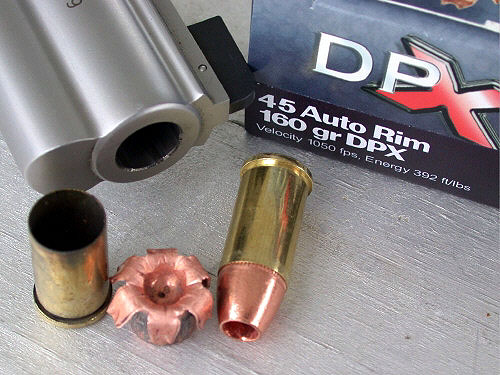
A revolver loaded with Corbon 45 auto rim 160-gr. DPX should be an effective defensive handgun that is easy to control and be effective on the receiving end.
For information on this and other Corbon ammunition or questions, here is a link to their site:
**************************************************************************************

